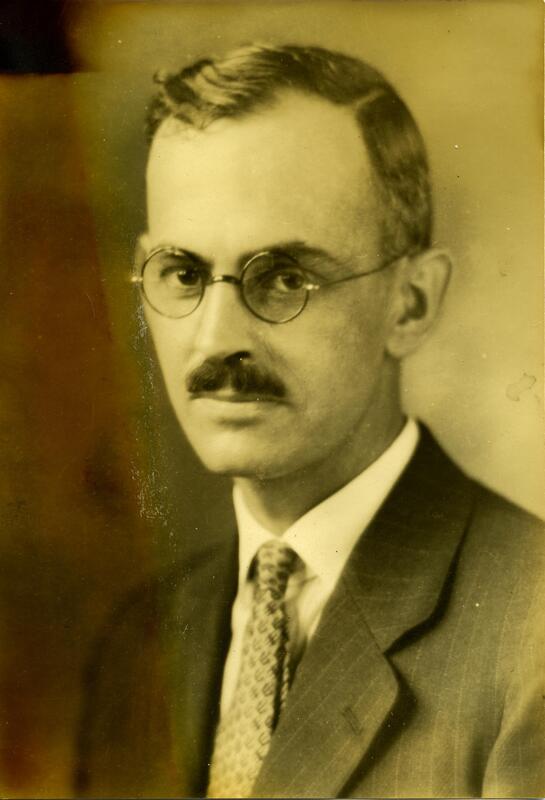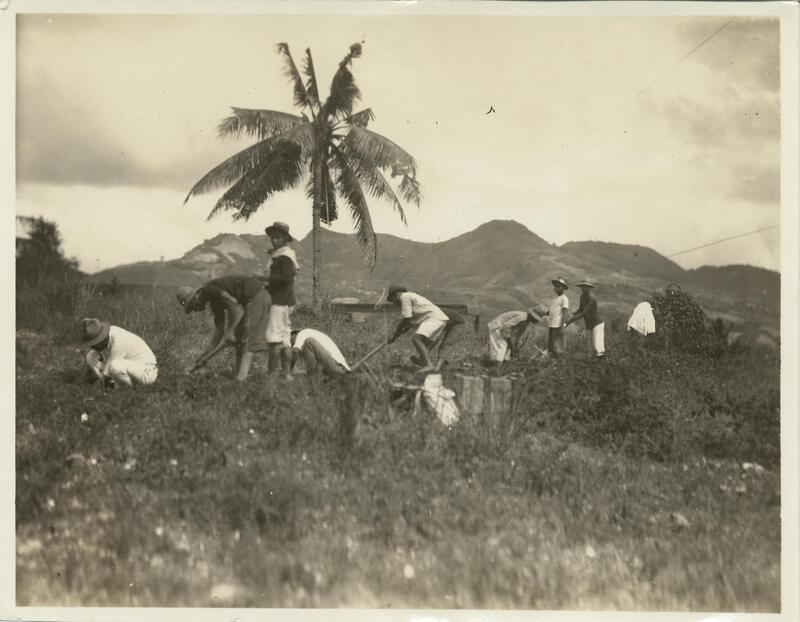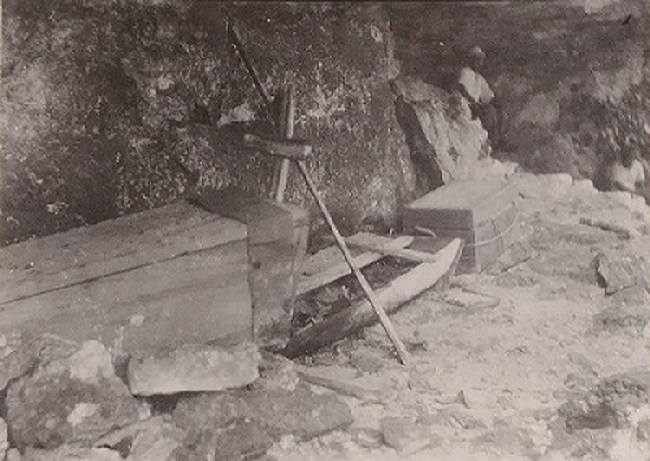Content Warning: This page discusses racism, racist language, death, and contains images of the desecration of graves.
Carl Eugen Guthe's Expeditions
Finding Pre-Colonial Culture in an Imperial Archive
From June 1922 to June 1925, anthropologist Carl Eugen Guthe led an expedition to the Philippines sponsored by the University of Michigan. The goal of the expedition was to collect pre-colonial Chinese ceramics via “the excavation of burial grounds.” Judged by the size of his collection, Guthe’s expedition was a rousing success.[1] His collection of ceramics, small artifacts, and human remains formed the backbone of the University of Michigan’s Museum of Anthropology, and modern scholars still refer to his collection as “arguably the most important collection of Philippine archaeological materials and Asian trade ceramics in the United States."[2]
Of course, Guthe did not amass this collection on his own. Instead, he relied heavily upon the labor and knowledge of local and indigenous people in the Philippines. At the same time, Guthe was only interested in the geographic knowledge local people possessed insofar as it helped him to locate burial sites. He dismissed all cultural knowledge and practices associated with the various grave sites he excavated as mythology at best and destructive at worst. In an article he wrote about the expedition in 1928, Guthe claimed that the people of the Philippines were “under Christian influence for such a long period” that they lacked any cultural or personal connection to the burial sites that he excavated.[3] This conclusion reflected the lens of colonization through which he conducted his research. He approached the people of the Philippines as a “racial primitive,” and most often lumped the various indigenous groups together under the umbrella term “native.”[4] Consequently, Guthe perceived that the indigenous peoples could only be “the object and never the source of knowledge."[5] Yet Guthe’s notes, letters, and reports provide ample evidence that some of the sites which he excavated continued to have cultural significance for the indigenous people whose ancestors were buried there. Thus, Guthe’s approach to the expedition shows how colonialism’s dismissive attitude towards indigenous knowledge can obscure continued indigenous cultural practices.
Guthe employed numerous indigenous people in a variety of roles throughout his expedition. He had, at most, seven permanent crew members who accompanied him on the Anne W. Day, the yacht owned by Dean C. Worcester that he lent to Guthe for the expedition. Most of the crew were local Filipinos.[6] However, this number fluctuated depending on which islands he visited during each trip. To supplement his workforce for excavations, Guthe frequently employed local people to guide him to burial sites and help dig as he traveled throughout the colony.[7] He also employed local people as “agents,” who traveled the Philippines purchasing artifacts and investigating rumors of burial sites.[8] Guthe gave special recognition to his agents in his annual reports to the university. He stressed that the agents’ greatest asset was their Filipino identity because it allowed the agents to obtain “information and [artifacts] which a white man would be incapable of securing.”[9] Guthe reiterated this point in his final annual report, in which he wrote that without the agents, he “could not possibly have covered the area” they reached nor bought the artifacts they had because “he was an American” not “a Filipino."[10]
It is impossible to get a full picture of why Filipinos chose to assist Guthe during his expedition using his papers. We know that some did so for financial reasons, as Guthe occasionally documented disputes between himself and his workers over pay.[11] However, this was not the case for all Filipinos who assisted the expedition. For example, on one occasion Guthe wrote that a Filipino man was "perfectly willing" to give the expedition a Chinese vessel, even as Guthe insisted that he'd "like to return it” to the man unless it was rare.[12] Unfortunately, Guthe’s papers do not provide any indication of the man’s motives for giving this pottery to the expedition. As discussed below, Guthe was only interested in local geographical knowledge. Therefore, he did not document any cultural or social practices or norms that may have influenced Filipinos to assist him. This gap in knowledge reveals one of the pitfalls of the collections created by imperialists like Guthe; they only include local information that the imperialist deems important. So, even where local voices shine through, they are still filtered through the lens of the colonial power.
The most important role that local Filipinos played in Guthe’s expedition was that of the informant. Guthe relied upon the knowledge of indigenous persons to find burial sites. Farmers often discovered grave sites while working their fields and contacted Guthe through his agents. He admitted in his first annual report that it would have been “impossible to locate burials without the aid of the native farmers.[13] Moreover, indigenous persons regularly informed Guthe about caves that contained burial sites. In a daily journal entry from his second trip in the Philippines, Guthe wrote that when arrived in the town of Caluiban, Leyte, the town’s leader brought out several older men with information about nearby caves.[14] In another instance, “an old Tambalan,” an indigenous healer, told Guthe of a cliffside cave near the island of El Nido which he said contained burial sites.[15] These are just two examples pulled from Guthe’s records of the expedition; his journals and correspondence are littered with more.[16]
However, Guthe’s interest in local knowledge only encompassed geography and the location of burial sites. Although Guthe recognized Filipinos’ importance to his success, he nevertheless looked down on them as ignorant and inferior. In a letter to a friend, Guthe expressed his frustration with local people, writing, “the common garden variety [emphasis added] are so stupid and have mental processes so divergent from our own….”[17] In another letter, he wrote that the “great mass of the natives... are essentially uncivilized….”[18] Therefore, when Guthe heard the explanations that different indigenous peoples gave for the burial sites, he brushed them aside as “superstitions” and “myths."[19] In so doing, Guthe undermined his later conclusion that the Filipinos did not retain a personal connection to their pre-colonial culture. While the influence of Catholicism certainly altered indigenous cultural and spiritual beliefs and practices, at least where the Spanish were able to establish control, some vestiges of indigeneity remained.
Although Guthe asserted that 300 years of Spanish imperialism had eliminated any memory of pre-colonial society, he often found evidence to the contrary. One clear piece of evidence was the existence of modern graves in some of the caves he excavated. Although some graves included Christian imagery, the placement of these graves in communal burial grounds alongside older graves suggests that those who used these caves were continuing pre-colonial cultural practices.
An even clearer indication that Guthe’s conclusion about local disinterest in burial sites was incorrect is the fact that he found many of the burial sites to still be in use. In his 1928 article, Guthe mentions that he repeatedly found coconut shells, “remains of candles and palm lead torches, and small offerings of money and ornaments” in many of the caves he searched. He noted that these findings provided “ample evidence” that indigenous people had recently left offerings for those individuals buried there.[20] He also found that some caves contained burials from after long after the beginning of colonization.[21] For example, Filipinos had recently constructed the two burial sites pictured above, with Guthe dating one of the sites to 1917, less than a five years before he arrived in the Philippines. But rather than taking this evidence as a sign that the indigenous peoples retained aspects of their pre-colonial culture, Guthe, whose sole focus was the collection of ceramics, other artifacts, and human remains, complained that the continued use of the burial sites had destroyed “valuable information and material” for his research.[22] Thus, for Guthe, indigenous practices “hamper[ed] the study of those practices.”[23] This approach to his study caused Guthe to overlook the fact that there were indigenous people in the Philippines engaging in pre-colonial cultural practices.
Although Carl Guthe insisted that Filipinos retained none of their pre-colonial cultural practices and beliefs, a close reading of his writings from his expedition undermines this sentiment. Guthe's conception of Filipino culture reflected his belief that Filipinos were a "racial primitive" that could only be "the object and never the source of knowledge.”[24] He employed Filipinos as laborers and relied upon the geographical knowledge of Filipino guides to find burial sites, but showed no interest in the cultural knowledge Filipinos might have had about burial sites upon which he intruded. However, throughout his journals and reports, Guthe documented evidence that some Filipinos continued to engage in pre-colonial practices and held the burial sites as sacred. He repeatedly mentioned finding signs that Filipinos had recently visited the burial sites he excavated and that they had left offerings for the dead. Yet, whether purposefully or accidentally, Guthe ignored these signs of continued indigenous cultural practice; instead he blamed Filipino visitors to the sites for the destruction of ceramics and loss of materials that he hoped to collect. Thus, Guthe's writings offer two valuable lessons. First, they show that despite hundreds of years of colonial rule, some Filipinos continued to practice elements of their pre-colonial culture(s). Second, they serve as a reminder that when reading an imperial archive, it is crucial to read against the grain to find information about the colonized that the author may have ignored or obscured.
Citations
[1] Letter from Carl E. Guthe to Dean. A. Worcester, Aug. 22, 1922, Dean. A. Worcester-Guthe Correspondence, 1923-1924, Box 1, Carl Eugen Guthe Papers, Bentley Historical Library, University of Michigan.
[2] Jamie L. Clark, "The Distribution and Cultural Context of Artificial Cranial Modification in the Central and Southern Philippines," Asian Perspectives 52, no. 1 (2013): 29.
[3] Carl. E. Guthe, “The University of Michigan Philippine Expedition,” American Anthropologist 29, no. 1 (Jan. - Mar. 1927): 72.
[4] Sarita Echavez See, The Filipino Primitive Accumulation and Resistance in the American Museum (New York, NY: NYU Press, 2017), 35.
[5] Ibid.
[6] Anne W. Day Crew List, Trip 1 Western Samar with Mr. Worcester November 6-12, 1922, Box 5, Carl Eugen Guthe Papers, Bentley Historical Library, University of Michigan.
[7] Journal entry for Dec. 9, 1922, Journals, Trip #2, Nov. 26-Dec. 14 1922, Western Samar, Northern Leyte, Trip #3, Feb. 9-Mar. 7, 1923, South Western Samar, Suluan (First Contact), Box 5, Carl Eugene Guthe Papers, Bentley Historical Library, University of Michigan; Journal entry for Feb. 13, 1923, Carl Eugene Guthe Papers, 1919-1942, Box 5, Journals, Trip #2, Nov. 26-Dec. 14 1922, Western Samar, Northern Leyte, Trip #3, Feb. 9-Mar. 7, 1923, South Western Samar, Suluan (First Contact): Journal Trip #3 - Feb. 13, 1923.
[8] The University of Michigan Philippines Expedition, First Annual Field Report: 1922-1923, 12-13, First Annual Field Report, 1922-1923, Box 1, Carl Eugen Guthe Papers, Bentley Historical Library, University of Michigan.
[9] The University of Michigan Philippines Expedition, Second Annual Field Report: 1923-1924, 5, Second Annual Field Report, 1923-1924, Box 1, Carl Eugen Guthe Papers, Bentley Historical Library, University of Michigan.
[10] The University of Michigan Philippines Expedition, Third Annual Field Report: 1924-1925, 5, Third Annual Field Report, 1923-1924, Box 1, Carl Eugen Guthe Papers, Bentley Historical Library, University of Michigan.
[11] Journal Entry for Dec. 9, 1922, Journals, Trip #2, Nov. 26-Dec. 14 1922, Western Samar, Northern Leyte, Trip #3, Feb. 9-Mar. 7, 1923, South Western Samar, Suluan (First Contact), Box 5, Carl Eugen Guthe Papers, Bentley Historical Library, University of Michigan.
[12] Journal Entry for Nov. 29, 1922, Journals, Trip #2, Nov. 26-Dec. 14 1922, Western Samar, Northern Leyte, Trip #3, Feb. 9-Mar. 7, 1923, South Western Samar, Suluan (First Contact), Box 5, Carl Eugen Guthe Papers, Bentley Historical Library, University of Michigan.
[13] The University of Michigan Philippines Expedition, First Annual Field Report: 1922-1923, 14, First Annual Field Report, 1922-1923, Box 1, Carl Eugen Guthe Papers, Bentley Historical Library, University of Michigan.
[14] Journal Entry for Nov 28. 1922, Journals, Trip #2, Nov. 26-Dec. 14 1922, Western Samar, Northern Leyte, Trip #3, Feb. 9-Mar. 7, 1923, South Western Samar, Suluan (First Contact), Box 5, Carl Eugen Guthe Papers, Bentley Historical Library, University of Michigan.
[15] Letter from Dean C. Worcester to Francis W. Kelsey, Nov. 16, 1922, Dean. A. Worcester-Guthe Correspondence, 1923-1924, Box 1, Carl Eugen Guthe Papers, Bentley Historical Library, University of Michigan.
[16] All of Guthe’s daily journals from his trips throughout the Philippines are available at the Bentley Historical Library in Ann Arbor, Michigan.
[17] Letter from Carl E. Guthe to Hearne, Dec. 6, 1924, Correspondence - Philippines, 1922-1925, Box 5, Carl Eugen Guthe Papers, Bentley Historical Library, University of Michigan.
[18] Letter from Carl E. Guthe to Bene, Oct. 27, 1924, Correspondence - Philippines, 1922-1925, Box 5, Carl Eugen Guthe Papers, Bentley Historical Library, University of Michigan.
[19] Journal Trip #2 - Nov 28, Journals, Trip #2, Nov. 26-Dec. 14 1922, Western Samar, Northern Leyte, Trip #3, Feb. 9-Mar. 7, 1923, South Western Samar, Suluan (First Contact), Box 5, Carl Eugen Guthe Papers, Bentley Historical Library, University of Michigan; Letter from Carl A. Guthe to Dean C. Worcester, Oct 31, 1923, Dean. A. Worcester-Guthe Correspondence, 1923-1924, Box 1, Carl Eugen Guthe Papers, Bentley Historical Library, University of Michigan.
[20] Guthe, “The University of Michigan Philippine Expedition,” 72.
[21] Journal entry for Feb. 28, 1923, Carl Eugen Guthe Papers, 1919-1942, Box 5, Journals, Trip #2, Nov. 26-Dec. 14 1922, Western Samar, Northern Leyte, Trip #3, Feb. 9-Mar. 7, 1923, South Western Samar, Suluan (First Contact): Journal Trip #3 - Feb. 13, 1923.
[22] The University of Michigan Philippines Expedition, First Annual Field Report: 1922-1923, 22, First Annual Field Report, 1922-1923, Box 1, Carl Eugen Guthe Papers, Bentley Historical Library, University of Michigan.
[23] See, Sarita Echavez See, The Filipino Primitive: Accumulation and Resistance in the American Museum (New York: New York University Press, 2017), 35.
[24] Ibid.




